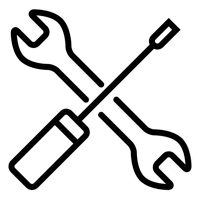AEMC 6471 Multifunction Digital Ground Resistance Tester Kit with Clamps - 300ft
Suitable for 4-Pole Soil Resistivity Wenner Testing
SKU code: 2135.6
The AEMC model 6471 ground resistance tester is available in a complete kit form, which includes the meter, a set of two SR182 current probes, rechargeable NiMH batteries, optical USB cable, power adapter 110/240V with power cord 115V US, two 300 ft color-coded leads on spools (red/blue), two 100 ft color-coded leads (hand-tied, green/black), four T-shaped auxiliary ground electrodes, set of five spaded lugs, one 100 ft AEMC® tape measure, DataView® software, ground tester workbook CD, carrying bag for meter and carrying bag for kit.
Features:
- Test ground resistance using the 2 clamp method (no auxiliary rods needed)
- 2- and 4-Pole Bond Resistance/Continuity measurement (DC Resistance) with automatic polarity reversal
- 3-Pole Fall-of-Potential measurement with manual or automatic frequency selection
- 4-Pole Soil Resistivity measurement with automatic calculation of Rho (r) and user selection of the Wenner or Schlumberger test method
- 3-Pole Earth Coupling measurement
- Manual and Automatic frequency scan from 41 to 513Hz for optimum test accuracy in electrically noisy environments
- Selectable test voltage of 16 or 32V up to 250mA of test current
- Auto-off power management
- Automatic recognition of all electrode connections and their resistance value
- Stores up to 512 complete test results in internal memory
- Optically isolated USB communication
- Remote set up and operation of all measurements using DataView® software
- Rechargeable NiMH batteries from wall charger or vehicle power
- Rugged dustproof and rainproof field case – IP54 rated in closed position
- Grounding standards IEC 61557 parts 4 and 5 compliant
- Includes DataView® software for data storage, real-time display, analysis, report generation and system configuration
Applications:
- 3-Point measurements of resistance to ground of ground rods and grids. 3-Point measurements are generally used when the electrode or grid can be easily disconnected.
- 4-Point tests or soil resistivity measurements. Locating areas of lowest soil resistivity is essential for achieving an economical grounding installation.
- Touch and step potential testing measurements. These tests are recommended when the ground cannot be disconnected, where ground faults are highly likely to occur, or when the “footprint” of grounded equipment (the outline of the part of equipment in contact with the earth) is comparable to the size of the ground to be tested.
- 2- or 4-Wire tests for continuity tests on bonding or on grounding systems. This test is a DC resistive test using 250mA or more and is used to check bonding of all connection points on the ground system.
- Earth coupling measurement and display. Used to estimate the influence of two earth resistance systems that are not connected to each other
Related products
More From This Category


















